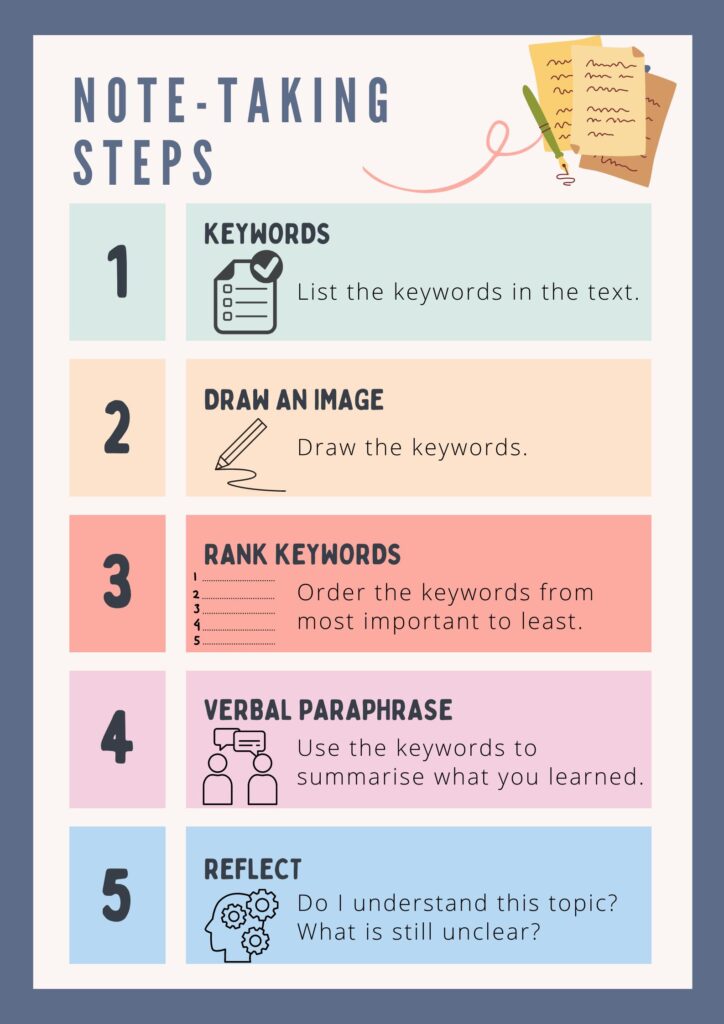5 Simple Note-taking Steps for Elementary Students

Note-taking is an essential skill that many students are expected to understand and use. Whether taking notes while listening to a speaker or reading, note-taking can be a challenging skill to learn for elementary-aged students. This process requires several skills that should be taught explicitly and practiced consistently to be used successfully.
So why is note-taking important? The purpose of note-taking is to aid the comprehension of new information, to understand it at a deeper level, and to transfer this learning to their long-term memories. Skilled note-taking can also help students avoid accidental plagiarism, think more critically about new information, and allow them to build on the ideas of others.
Several strategies can be used for note-taking; however, many traditional methods are often relatively passive and don’t engage students or encourage a deeper level of understanding. The following note-taking steps involve active learning strategies that have shown to be particularly effective for elementary-aged students.

Step 1: Identify Keywords
The first step in this process is identifying keywords or phrases. This step can be the most challenging and may take longer to apply the first time it is introduced. However, once this skill has been mastered, it is helpful across all subjects.
When introducing the concept of keywords, it can be helpful to have a shared piece of text to practice locating these words together. Read a short non-fiction or fiction passage together and ask students the following questions, making a list of possible keywords together.
- If you were to tell someone what this paragraph is about, which words or phrases would you have to use?
- Which words can’t be replaced without losing the meaning of the text?
Students may notice that many of the keywords are nouns and verbs. If students need further support, they can be asked the following questions;
- Are there any important words or phrases related to time or when something happened?
- Are there words about people?
- Are there words describing a choice someone made?
- Are there words about a location or place?
- Are there words about the way something is done?
As students continue to practice this skill, they can also be given the keywords to proceed to the next step.
Step 2: Create a visual representation
Once students have identified the keywords in a text, the next step is to create a visual representation of the word. This allows students to develop a deeper understanding of the word and what it means.
In this step, students should draw a quick sketch of what each of their keywords means. Students can draw just the nouns or the five most essential words if there are too many words. You can change the parameters depending on the information they are taking notes on.
The noun project is an excellent resource for students who find drawing challenging.
This is also an excellent activity for EAL (English as an Additional Language) students, as it helps build vocabulary and make connections between their first language and English.
Step 3: Ranking Keywords
To encourage critical thinking and gain a deeper understanding, ask students to rank the keywords from most important to least. If there are too many words, students can select the 5 or 10 most influential and rank these.
There is no correct answer, so how students order the words is unimportant. The value of this task comes from promoting discussions and having to justify their choices.
By pairing students up, they can be encouraged to have richer conversations as they grapple with their thinking. This process generally leads to a much better understanding of the topic.
Step 4: Verbal Paraphrasing
Once students have thought critically about their chosen keywords, they can begin to articulate their understanding verbally and practice paraphrasing.
This is a crucial step as it lets you see students’ understanding of the keywords and the text overall.
Using the list of keywords created in Step 1, students should now practice summarising what they read using all the keywords they listed. As they begin this process, they will become aware of which words they have yet to understand fully and which may not be as important as they first thought.
Students can be given an additional challenge by asking them to quiz each other using their keywords.
Step 5: Reflect
The final step in this process allows students and teachers to identify which words and concepts were understood and which need further practice. This form of self-assessment is quick and allows the students to recognise what they need further help with independently.
Students can be asked to reflect on the following questions;
- Do I understand what these keywords mean?
- Was I able to explain them to myself or someone else?
- What is still unclear to me?
While note-taking can initially seem challenging, consistent practice and repetition will help students master this process. Not only is it a practical skill that students need, but this process also allows them to develop a deeper understanding of the given topic.
Key Takeaways
- Note-taking is an essential skill that many students are expected to understand and use.
- This process requires several skills that should be taught explicitly and practiced consistently to be used successfully.
- The purpose of note-taking is to aid the comprehension of new information, to understand it at a deeper level, and to transfer this learning to their long-term memories.
- Step 1: identify keywords or phrases.
- Step 2: create a visual representation of the word.
- Step 3: to encourage critical thinking and gain a deeper understanding, ask students to rank the keywords from most important to least
- Step 4: verbally paraphrase what they read using the keywords
- Step 5: students reflect on what they understood and what they need more help with
